| کد مقاله | کد نشریه | سال انتشار | مقاله انگلیسی | نسخه تمام متن |
|---|---|---|---|---|
| 3970168 | 1256704 | 2014 | 10 صفحه PDF | دانلود رایگان |
Assisted oocyte activation (AOA) using a calcium ionophore has been used for more than a decade following intracytoplasmic sperm injection (ICSI) fertilization failure. However, since AOA does not mimic precisely the physiological fertilization process, concerns exist about its use in human assisted reproduction. This study assessed the neonatal and neurodevelopmental outcome of children aged ⩾3 years who had been born following AOA in our centre. Twenty-one children participated in the study (81% response rate; mean age 63.6 ± 21.07 months). Neonatal data were collected via questionnaires. Neurodevelopmental outcome was tested using the Reynell Developmental Language Scales or Clinical Evaluation of Language Fundamentals, Wechsler Preschool and Primary Scale of Intelligence or Wechsler Intelligence Scale for Children, and the Movement Assessment Battery for Children III. Behaviour was scored by the Social Communication Questionnaire, the Child Behaviour Checklist and the Teachers Report Form. For all tests and questionnaires, the mean outcomes lay within the expected ranges. These are first data on the developmental outcome of AOA children. The high response rate and the robustness of the tests support the data, which are reassuring although still considered preliminary. Therefore, AOA should still be performed only in selected couples.Intracytoplasmic sperm injection (ICSI) is a very efficient technique used in couples suffering from severe male subfertility. However, in a minority of those couples, ICSI does not lead to normal fertilization rates. In those couples, only very few or often no embryos at all are available for embryo transfer. Assisted oocyte activation (AOA) is a highly specialized fertilization technique which can be added to conventional ICSI to overcome fertilization failure in those couples. Since the late 1990s, many centres have been performing AOA in this rare group of patients. However, until adequate scientific evidence is provided regarding its safety and efficacy, AOA cannot yet be considered an established treatment. We assessed the outcome of children aged ⩾3 years who had been born following AOA in our centre. Twenty-one children participated in our study (81% response rate; mean age 63.6 ± 21.07 months). We used questionnaires as well as age-adjusted tests to assess neonatal data, the cognitive skills, language skills, motor skills and behaviour of those children. For all tests and questionnaires, the outcomes were within the expected ranges. These are first data on the developmental outcome of AOA children. The high response rate and the robustness of the tests support the data, which are reassuring. However, because the total number of children born following AOA is still low, these results should be considered preliminary. Therefore, AOA should still be performed only in selected couples.
Journal: Reproductive BioMedicine Online - Volume 28, Issue 1, January 2014, Pages 54–63
